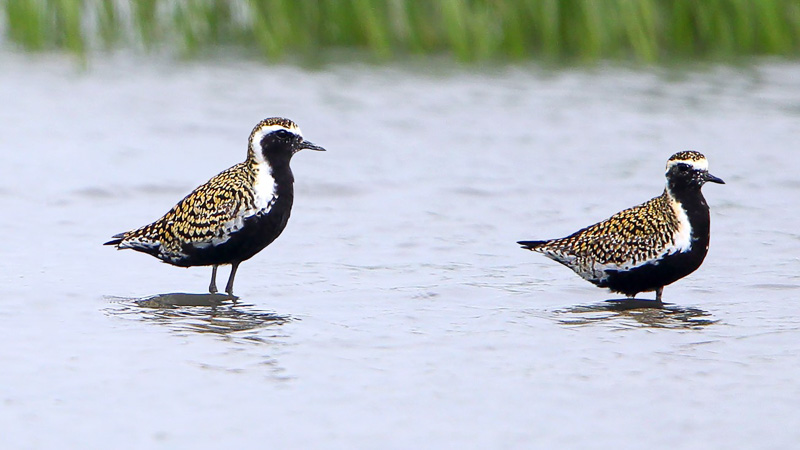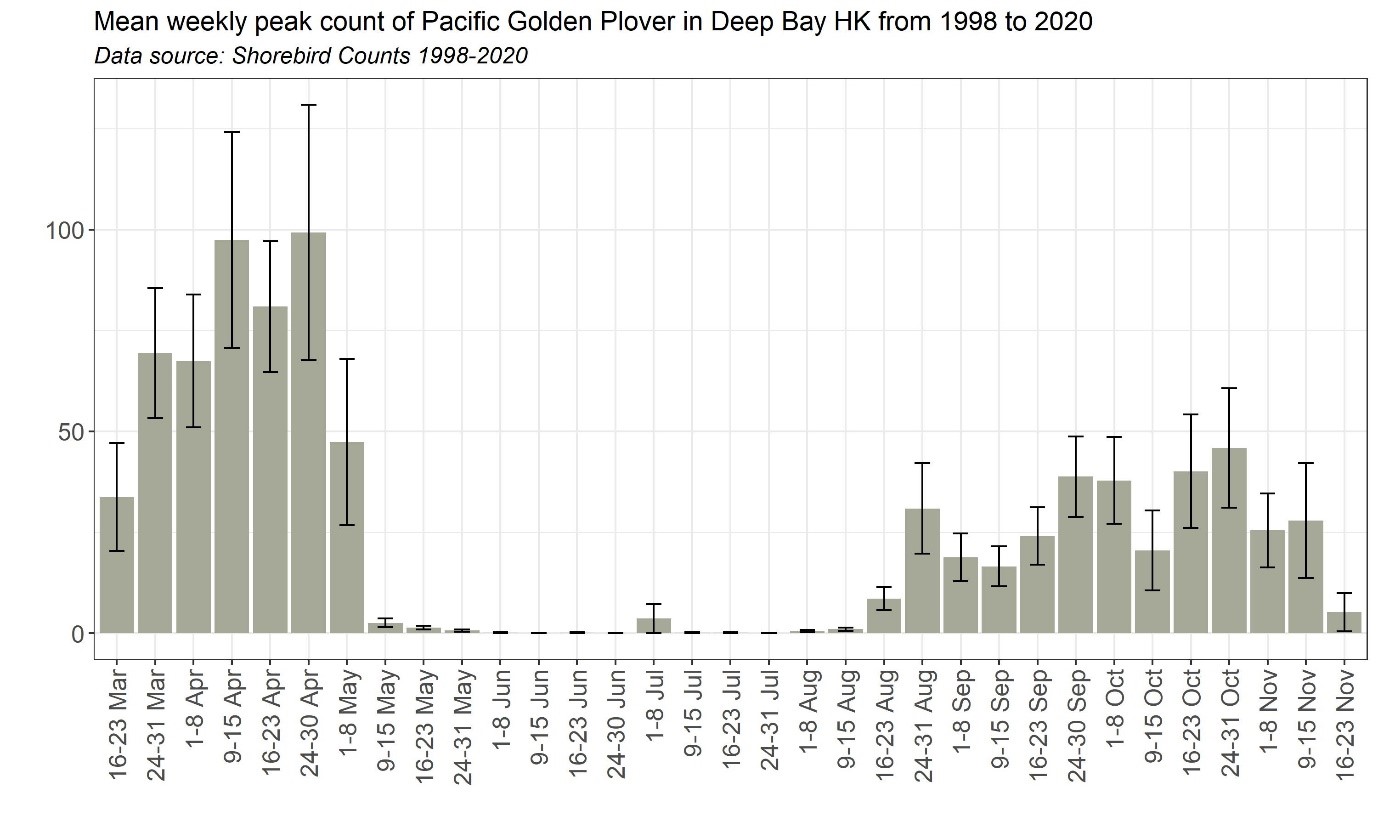Pacific Golden Plover Pluvialis fulva 太平洋金斑鴴
Category I. Common passage migrant and abundant winter visitor.
IDENTIFICATION

May 2016, Michelle and Peter Wong. Adults, breeding plumage.
21-25 cm. The smallest of the three Pluvialis species recorded in HK. On all birds the upperpart feathers are dark with golden-buff or whitish notches around the feather edges, while the axillaries and inner underwing are greyish.
In breeding plumage has extensive black below with a buff or white forehead that becomes white and extends round the rear of the face and along the flanks.

Dec. 2024, Paul Leader. First calendar-year.
Adults and first calendar-year birds in autumn and early winter have less complex markings than unmoulted juveniles on the upperparts and lack clear streaks or bars on the underparts. The contrast between the worn outer greater coverts and fresher inners and scapulars suggests this is a first calendar-year bird.

Oct. 2010, Michelle and Peter Wong. Juvenile.
In non-breeding plumage notably brighter and less grey than Grey Plover, though rarely grey variants do occur. Underparts are pale buff below with whitish from belly to undertail coverts. There is a distinct golden buff wash to the head, a diffuse dark spot behind and below the eye and a moderately strong capped effect. Juveniles have notched, uniformly neat feathers on the upperparts and brownish streaks on the chest.
VOCALISATIONS
The most frequent flight call is a whistled and sharply downslurred ‘tluuee’ that can be uttered hurriedly and anxiously or in a rather more relaxed tone.
Also, a whistled ‘teeee’, even or slightly rising in pitch, and an inflected ‘tueee’:
DISTRIBUTION & HABITAT PREFERENCE
The great majority of records are from the intertidal mudflats of Deep Bay and adjacent roosting areas of Mai Po NR and the commercial fish pond areas. However, wintering birds are generally only seen in the intertidal areas, their high tide roosting area usually remaining unknown.
The extensive grassy areas at the former and present airports of Kai Tak and Chek Lap Kok respectively account for many records away from Deep Bay, with up to 45 birds in spring and 19 in autumn. Other records have occurred in widespread areas on migration over the sea south of HK, at Tai Mo Shan, Lantau and other islands, Sai Kung and Sha Tau Kok. The highest count away from the northern New Territories is of 200 at Shuen Wan on 10 September 2002; otherwise, such records concern 20 birds or fewer. At Long Valley small numbers, usually up to five, are regularly recorded on spring and autumn passage.
OCCURRENCE
Shorebird counts since 1998 (Figure 1) indicate that Pacific Golden Plover is common in both spring and autumn, though more numerous in the former. Peak spring passage occurs during the last three weeks of April, and there is a sharp drop in numbers after the first week of May. From the second week of May to the middle of August, most counts are in single figures. Southward passage is obvious from the third week of August, and numbers gradually build up to a to peak in October.
The wintering flock in the intertidal areas of Deep Bay numbered no more than 250 up to winter 2006/07 (Figure 2), and the lack of birds up to the mid-1980s reflects the lack of access to the intertidal areas. It was recorded in three-figures during waterbird counts from 1991/92 to 1997/98, but more erratically subsequently. During the three winter periods beginning 2004/05 no more than 57 birds were recorded. However, winter 2007/08 saw a peak count of 520 birds, and this marked the beginning of a period when the wintering flock generally numbered 400 birds or more. Based on winter waterbird counts in Deep Bay, Sung et al. (2021) concluded that the wintering population increased between 1998 and 2017. The highest winter period count is 853 on 24 January 2011, while the highest on record in HK is 900 on 13 April 1992.
Kershaw (1904), regarding HK, and La Touche (1931-34) regarding Guangdong, refer to Pacific Golden Plover as common in winter. Vaughan and Jones (1913) stated that it passed through on migration, with most birds noted during the second half of April, and Herklots (1953) described a similar picture.
BEHAVIOUR, FORAGING & DIET
Habitually flocks, forming dense groups of birds in flight over the intertidal mudflats of Deep Bay, alighting together on exposed mudflat. Forages using a series of runs, stops and pecks as required to locate and feed on invertebrate prey in both intertidal and freshwater wetlands, though mainly the former.
RANGE & SYSTEMATICS
Monotypic. Breeds across northern Siberia tundra from the Yamal Peninsula east to the Bering Sea and western Alaska, as well as south to the Kamchatka Peninsula and Magadan. Winters across large swathe of coastal areas from east Africa through India, south China and southeast Asia to Indonesia and Australasia (Johnson et al. 2021). In China a migrant through the eastern half of the country and northern Xinjiang to winter in southern coastal areas, including Hainan and Taiwan (Liu and Chen 2020).
CONSERVATION STATUS
IUCN: Least Concern. Population trend decreasing.
Figure 1.

Figure 2.

Herklots, G. A. C. (1953). Hong Kong Birds. South China Morning Post, Hong Kong.
Johnson, O. W., P. G. Connors, and P. Pyle (2021). Pacific Golden-Plover (Pluvialis fulva), version 1.1. In Birds of the World (P. G. Rodewald, B. K. Keeney, and S. M. Billerman, Editors). Cornell Lab of Ornithology, Ithaca, NY, USA. https://doi.org/10.2173/bow.pagplo.01.1
Kershaw. J. C. (1904). List of birds of the Quangtung Coast, China. Ibis 1904: 235-248.
La Touche, J. D. D. (1931-34). Handbook of the birds of Eastern China Vol. 2. Taylor and Francis, London.
Liu, Y. and Y. H. Chen (eds) (2020). The CNG Field Guide to the Birds of China (in Chinese). Hunan Science and Technology Publication House, Changsha.
Sung, Y. H., C. C. Pang, T. C. H. Li, P. P. Y. Wong and Y. Y. Yu (2021). Ecological Correlates of 20-Year Population Trends of Wintering Waterbirds in Deep Bay, South China. Frontiers in Ecology and Evolution. Published 20 April 2021 doi: 10.3389/fevo.2021.658084

